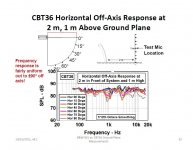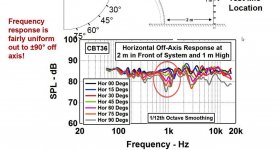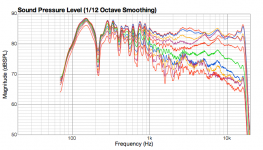Remember how and where this is measured. If we are going to compare real data, the speakers need to be measured identically and under correct conditions. Right?geez... what a mess! can't You see it??fairly uniform ????

I have by the way measured Geddes Abbey and CBT36 in same rooms. But I'm not planning to post it. That would be unfair for several reasons.
http://audioartistry.com/brochures/B&W 801 vs. CBT36 Ground-Plane Measurements v8.1.pdf
Here's some measurements of the CBT. On page 31 there's a horizontal off-axis ground plane measurement. Still seems to show some diffraction issues.
Here's some measurements of the CBT. On page 31 there's a horizontal off-axis ground plane measurement. Still seems to show some diffraction issues.
I have by the way measured Geddes Abbey and CBT36 in same rooms. But I'm not planning to post it. That would be unfair for several reasons.
Why not ? Those reasons being ?
http://audioartistry.com/brochures/B&W 801 vs. CBT36 Ground-Plane Measurements v8.1.pdf
Here's some measurements of the CBT. On page 31 there's a horizontal off-axis ground plane measurement.
so this is actually a ground plane measurement by Mr Keele Himself and as such it doesn't include "the room's comb filtering", does it Omholt?
in one word - it's a mess
Why not ? Those reasons being ?
yeah - exactly - why not??? what would be unfair about it?
Attachments
http://audioartistry.com/brochures/B&W 801 vs. CBT36 Ground-Plane Measurements v8.1.pdf
Here's some measurements of the CBT. On page 31 there's a horizontal off-axis ground plane measurement. Still seems to show some diffraction issues.
How come the B&W was measured as is while the CBT (Makes me snigger every time,I should never have watched online porn)
got DSP processing?
Does it make any difference for the question at hand?
I've been thinking more about planar drivers today. I have some neo magnets already, it might be time to try building a planar tweeter and horn loading it. A nice thing about making a tweeter for the horn would be that you can tune its response. I'm not sure that a ribbon would tolerant the pressure from the mids further up the throat, but it's worth a try. Planar magnetic instead, maybe.
I have planar drivers in my headphones that I can experiment with first for dispersion (if not SPL). I used a big mouse pad to make a conical horn and the planar diaphragm was already well behaved down to 1 kHz. Mouth termination is easy with a planar wavefront.
I can't help but feel that a compression driver is overkill in the home, though I've never heard any such systems.
I have planar drivers in my headphones that I can experiment with first for dispersion (if not SPL). I used a big mouse pad to make a conical horn and the planar diaphragm was already well behaved down to 1 kHz. Mouth termination is easy with a planar wavefront.
I can't help but feel that a compression driver is overkill in the home, though I've never heard any such systems.
I presume you mean my post, yes i'd be interested in at least exploring the idea further and hearing Toms take on it. I'm not in a position of being able to actually install the speakers directly into the wall/corner as a sofit-mounted corner unity horn (renting), but if I was going to build a unity/synergy horn, that would be how
It's a classical collapsing polar response. Not very uniform.
What are you talking about?
The off axis FR falls uniformly.
i use the cheap but cheerful Fountek neoCD3.5H hornWG loaded planar. Its called a ribbon, but its a sandwhich diaphragm. Its rated at 25W and 95.5dB/W on the spec i have. The waveguide is removable, 3 x 3/8 inch ribbon. It could be a good candidate for a larger horn....In the short hornWG the raw FR starts to roll off at around 980hz. Im guessing the ribbons resonance is there, since i think its more of a waveguide rather than anything else.
Last edited:
I can't help but feel that a compression driver is overkill in the home, though I've never heard any such systems.
Not really.
The advantage is that compared to domes or cones they can produce adequate SPLs with little audible distortion. Thus you don't have to pad the down the LF driver.
For home use a decent 1" CD can be crossed starting maybe about 900 - 1200 Hz and a good woofer will still be clean.
The downside is that the boxes can't be tiny.
Usual caveat applies: it depends on competent implementation.
I crossed a cheap Selenium D220Ti on a 12" horn at 1 khz and it coped without a sweat, even at ear-splitting levels. With a sine-sweep at about 105 dB it had less than 1% distortion throughout its band, except around 7 or 8 khz where the driver has some issues. Just above the crossover-frequency it was actually even lower than at higher frequencies. I wouldn't hesitate to cross the driver even lower on a larger horn.
This one is measured in a room with uneven floor and includes the room's comb filtering.
From http://audioartistry.com/brochures/B&W 801 vs. CBT36 Ground-Plane Measurements v8.1.pdf: "Impulse responses were windowed with a 50 ms half‐Hann window"
An externally hosted image should be here but it was not working when we last tested it.
The vertical dispersion problem of a typical two-way box now has become a horizontal dispersion problem in the CBT (see attachment). What's more important to you? Horizontal or vertical smoothness?
Attachments
Last edited:
From http://audioartistry.com/brochures/B&W 801 vs. CBT36 Ground-Plane Measurements v8.1.pdf: "Impulse responses were windowed with a 50 ms half‐Hann window"
in other words: "These measurements assess the sound field generated by the systems when operated in a non‐anechoic environment but over a reflective ground plane."
so much for CBT as any sort of a technical revelation and Holy Grail solution
ps. OTOH I understand perfectly that one may like the sound of it or that some women may be attracted to the shape of it
CBT = Constant Beamwidth Transducer
Don Keele's CBT (Constant Beamwidth Transducer) Page
Don Keele's CBT (Constant Beamwidth Transducer) Page
There's not much discussing when you guys cannot see that measurements in a normal room with uneven floor effects it. Looks like you already have decided what you want to see but you may be judging on wrong assumptions.
My experience tell me that CBT meassures overall flatter then a good waveguide, even in small rooms. I have not seen the waveguide being clearly flatter at any frequencies, but they were about the same above 4 Khz. The impulse response is also very clean, but perhaps not as good as a Geddes speaker.
And I think you seem to fail to grasp the importance of reflected energy being close to the direct signal and don't understand that a polar response that becomes narrower and narrower is an effective EQ of a system. Which psycoacoustic studies tells us that a narrow treble dispersion is favorable? Aren't they telling us the opposite?
Hopefully Don Keele will soon provide more measurements.
My experience tell me that CBT meassures overall flatter then a good waveguide, even in small rooms. I have not seen the waveguide being clearly flatter at any frequencies, but they were about the same above 4 Khz. The impulse response is also very clean, but perhaps not as good as a Geddes speaker.
And I think you seem to fail to grasp the importance of reflected energy being close to the direct signal and don't understand that a polar response that becomes narrower and narrower is an effective EQ of a system. Which psycoacoustic studies tells us that a narrow treble dispersion is favorable? Aren't they telling us the opposite?
Hopefully Don Keele will soon provide more measurements.
There's not much discussing when you guys cannot see that measurements in a normal room with uneven floor effects it. Looks like you already have decided what you want to see but you may be judging on wrong assumptions.
"Uneven floor"? The floor shown in the linked PDF is not uneven at all!
Which psycoacoustic studies tells us that a narrow treble dispersion is favorable? Aren't they telling us the opposite?
That is the question and we still don't know the answer. CBT or Geddes is of no importance to me as they are just different technical implementations with very different results. The real question is which result is desirable and which one is not. So far we've heard a lot of beliefs but no hard facts. (Audio) business as usual.
Hopefully Don Keele will soon provide more measurements.
I agree.
What we all need to remember is that there is no Holy Grail in producing the perfect sound reproducing device with perfect polar response in both the vertical and horizontal planes simultaneously. As the graph that Markus put up shows real world response anomalies for the so called CBT design we can show the same for a BR enclosures, or a OB enclosure, or cardioid, or any other implementation. I am sick of hearing the term CD as far as any Conic horn lens goes also, these are all marketing terms, none of them are so when looked at critically. There are no CD horn lenses in any form, none, just as the CBT is not constant beam-width. Just as you would question every single capacitors specification, or opamp, or electrical topology you have to look with the same jaundiced eye at all the claims that are made for every type of loudspeaker. When you find the Holy Grail of perfect loudspeaker polar response give me a call, I'll sell you a bridge to nowhere. All you can really do is chose what makes you happy and satisfies as best as you can find your own personal tastes. But stop trying to sell any one implementation as perfect or even close. That is really what makes this whole musical trip so incredibly interesting after 100 years. We are all still looking for what works best and the quest goes on.
And I think you seem to fail to grasp the importance of reflected energy being close to the direct signal and don't understand that a polar response that becomes narrower and narrower is an effective EQ of a system.
some probably fail to grasp but certainly not me
my goals are the same - elimination of the destructive floor reflection and getting all lateral reflections as similar to the direct sound as possible
to achieve that I propose a floor coupled loudspeaker (nicknamed by another diyaudio user as a flooder) with horizontally constant dispersion
furthermore to get all 1st order reflections delayed by more than 10 ms in a moderately sized room I propose a side-wall positioning a la Beveridge with effective integration of the speaker into the wall by means of a "virtual wall" - inspired by and analogous to the Snell "Type 1"'s virtual floor for the tweeter aka "the wheelchair ramp"
- Status
- This old topic is closed. If you want to reopen this topic, contact a moderator using the "Report Post" button.
- Home
- General Interest
- Room Acoustics & Mods
- Controlled vs wide dispersion in a normal living room environment..


